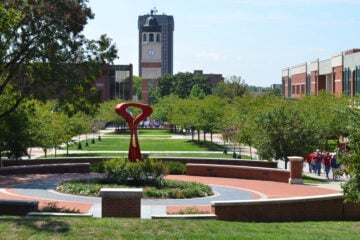NPR has ‘not completely bounced back’ from pandemic’s impact on revenue, says acting CEO

April Simpson / Current
NPR has rolled back some cuts made to staff benefits last year, but the network has not fully recovered from the financial hit it experienced due to the pandemic.
“We have not completely bounced back. We are still emerging,” said NPR Acting CEO Deborah Cowan April 9 during the Texas Public Media Staff Summit. Cowan, whose permanent role at NPR is CFO, is serving as acting CEO while John Lansing is on medical leave.
NPR cut spending in areas including staff and executive pay to offset a decline in revenue spurred by the pandemic, particularly in corporate sponsorship. The network’s revenue is “slightly above” its 2019 income but hasn’t reached 2020 levels, Cowan said.
Next year, NPR will aim to completely roll back the budget cuts that staffers agreed to last year in order to avoid layoffs. That timeline is “not totally clear yet,” Cowan said.
Cowan spoke alongside PBS President Paula Kerger during the summit, the first of what is expected to be an annual meeting among public media staffers in Texas. During a discussion moderated by Krys Boyd, host of KERA’s Think, the leaders addressed a range of topics, including collaborations between their networks, the future of work, and how the past year has changed their organizations.
PBS is in a “slightly different” financial circumstance than NPR’s because the proportion of its revenue that comes from corporate support is “significantly smaller” than NPR’s, Kerger said.
PBS has laid off some staffers during the pandemic, but Kerger said that was because “there were jobs that no longer existed and would not exist for a period of time.”
“On the TV side … our viewership has gone up,” Kerger said. “People are home more, so they’re watching more of PBS. And a number of stations have reported that their membership revenue has gone up.”
The two leaders said the past year has forced their organizations to adapt in ways that they didn’t think were possible in the past.
At NPR, Cowan pointed to making the production of newscasts and newsmagazines entirely remote.
“I remember celebrating the first newscast that we took 100% remote,” Cowan said. “It was a big deal. And now looking back that all newscasts are 100% remote, it just seems so smooth.”
“Two years ago if you’d asked us, could we fire up the newsmags in a remote fashion 100%, we would have said no,” Cowan added. “… It really showed just the capacity, the ability and the will to overcome very difficult challenges and what we thought were impossible situations.”
Room for news collaborations
While NPR has been able to take its broadcast operations remote, increased vaccine availability is leading the network to begin “looking into how we reach a compact with our employees to determine what their work will look like going forward,” Cowan said.
Kerger said that during the past year, she has used her her cellphone more often for broadcast recordings, such as an interview for CBS Sunday Morning. “Two years ago, a year and a half ago, would we have thought that was possible? No,” she said.
Kerger said that she has taken away from that change that “we should give ourselves more flexibility around the work that we do and allow ourselves to really imagine that, no, we don’t always have to do things in the way that we’ve done for many years or even over the last couple of years.”
That doesn’t mean that PBS will rely on a remote workforce moving forward, she said. “We need to have people in the building to work collaboratively,” Kerger said, but PBS is still sorting out the details of those arrangements.
Kerger added that “being nimble and being responsive and being willing to take some risk … those are the attributes that I would encourage all of us to really think about. Because as nonprofit organizations, it’s hard for us to take risks sometimes. I mean, you’re so worried that you’re going to disappoint our funders and the people that have invested in us. But if we can’t take risk and we don’t fail occasionally, then we’re not growing as an organization.”
One positive result of the past year has been that it has humanized journalists, Kerger said.
“As a visual medium, everyone knows Lisa Desjardins’ cat and Judy Woodruff’s study and so forth,” she said.
In response to a question about possible collaborations between NPR and PBS, Cowan said that the networks are actively working on collaborations around the content management system Grove and an interconnection pilot.
Kerger said that she sees more room for collaboration on news. “We do have ongoing conversations around editorial and ways that we might do that even more effectively,” she said, pointing to examples such as NPR journalists appearing on NewsHour or Washington Week.
“The answer to journalism in this country is not Bezos and billionaire investors,” Kerger said. “I think part of the answer is us. … If we could figure out ways that we could better align some of our work between public television and public radio, it would be hugely powerful.”






My opinion:
The reason you could be suffering may have more to do with a continued journalistic tilt towards favoring corporations in your stories and doing the same in political coverage. You have managed to haze the “Public” in “Public Radio” and so the public is quietly and regretfully walking away….
Faqm Mall